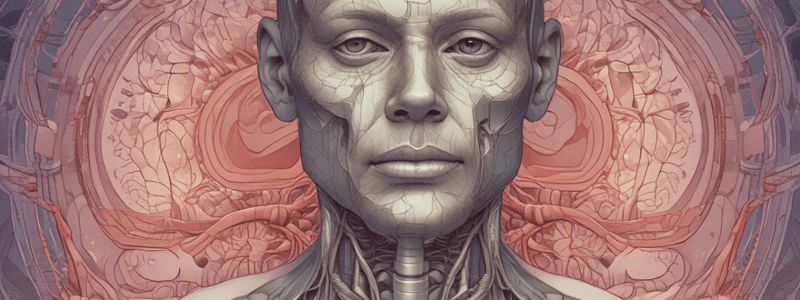Podcast
Questions and Answers
What is the total number of ribs in the human body?
What is the total number of ribs in the human body?
- 24 (correct)
- 14
- 7
- 12
What is the function of the intercostal muscles?
What is the function of the intercostal muscles?
- To expand the lungs
- To move the sternum
- To contract and move the ribs outwards (correct)
- To breathe out
What is the name of the bone in the middle of the chest?
What is the name of the bone in the middle of the chest?
- Breastbone (correct)
- Ribcage
- Sternum (correct)
- Rib
How many pairs of ribs attach directly to the sternum?
How many pairs of ribs attach directly to the sternum?
What controls the contraction of the intercostal muscles?
What controls the contraction of the intercostal muscles?
What is the term for 'between' in the context of the intercostal muscles?
What is the term for 'between' in the context of the intercostal muscles?
What happens to the ribs when the intercostal muscles contract?
What happens to the ribs when the intercostal muscles contract?
What is the shape of the muscle that rides down the bottom of the ribcage?
What is the shape of the muscle that rides down the bottom of the ribcage?
What happens to the alveoli when the protein molecules snap back into their original size?
What happens to the alveoli when the protein molecules snap back into their original size?
What type of energy is required for inhaling?
What type of energy is required for inhaling?
What drives the process of exhaling?
What drives the process of exhaling?
What is the result of the protein molecules snapping back into their original size?
What is the result of the protein molecules snapping back into their original size?
What is the energy source used during exhaling?
What is the energy source used during exhaling?
What is the difference between inhaling and exhaling in terms of energy usage?
What is the difference between inhaling and exhaling in terms of energy usage?
What is the shape of the diaphragm muscle when it is relaxed?
What is the shape of the diaphragm muscle when it is relaxed?
What happens to the heart and lungs when the diaphragm muscle contracts?
What happens to the heart and lungs when the diaphragm muscle contracts?
What is the function of elastin protein in the alveoli?
What is the function of elastin protein in the alveoli?
What happens to the volume of the lungs when the diaphragm muscle contracts and the intercostal muscles move out?
What happens to the volume of the lungs when the diaphragm muscle contracts and the intercostal muscles move out?
What is the approximate number of alveoli in the human lungs?
What is the approximate number of alveoli in the human lungs?
What happens to the elastin molecules when the muscles relax?
What happens to the elastin molecules when the muscles relax?
What is the driving force for why the volume goes back down during exhalation?
What is the driving force for why the volume goes back down during exhalation?
What happens to the alveoli when the diaphragm muscle contracts and the intercostal muscles move out?
What happens to the alveoli when the diaphragm muscle contracts and the intercostal muscles move out?
What is the result of the diaphragm muscle contracting and the intercostal muscles moving out?
What is the result of the diaphragm muscle contracting and the intercostal muscles moving out?
What is the purpose of the diaphragm muscle contracting?
What is the purpose of the diaphragm muscle contracting?
Flashcards are hidden until you start studying
Study Notes
Breathing Process
- The breastbone, also known as the sternum, is a bone in the middle of the chest where the ribs attach.
- There are 24 ribs in total, with 14 ribs attaching directly to the sternum.
- Between the ribs, there are intercostal muscles that are controlled by the brain and play a crucial role in the breathing process.
Inhaling
- When the brain signals to take a deep breath, the intercostal muscles contract, causing the ribs to move outwards.
- The diaphragm muscle, which is dome-shaped, contracts and flattens, moving downwards and increasing the volume of the thoracic cavity.
- As the diaphragm moves down, the lungs and heart are physically moved downwards and outwards, expanding the lung volume.
- The expansion of the lungs is due to the stretching of alveoli, which increases their size.
- There are approximately 500 million alveoli, each surrounded by protein called elastin, which acts like a rubber band.
Exhaling
- When the muscles relax, the elastin proteins snap back, causing the alveoli to recoil and decrease in size, reducing the lung volume.
- The recoil of the elastin proteins is the driving force behind the decrease in volume during exhalation.
- Exhaling does not require chemical energy, unlike inhaling, which uses ATP (adenosine triphosphate) for muscle contraction.
- The process of inhaling and exhaling is distinct, with inhaling requiring energy and exhalation driven by elastic potential energy.
Studying That Suits You
Use AI to generate personalized quizzes and flashcards to suit your learning preferences.



